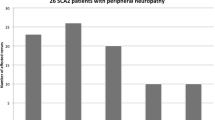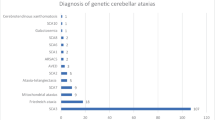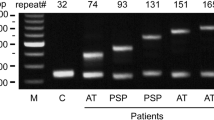Abstract
Spinocerebellar ataxias (SCAs) are characterized by autosomal dominantly inherited progressive ataxia but are clinically heterogeneous due to variable involvement of non-cerebellar parts of the nervous system. Non-cerebellar symptoms contribute significantly to the burden of SCAs, may guide the clinician to the underlying genetic subtype, and might be useful markers to monitor disease. Peripheral neuropathy is frequently observed in SCA, but subtype-specific features and subclinical manifestations have rarely been evaluated. We performed a multicenter nerve conduction study with 162 patients with genetically confirmed SCA1, SCA2, SCA3, and SCA6. The study proved peripheral nerves to be involved in the neurodegenerative process in 82 % of SCA1, 63 % of SCA2, 55 % of SCA3, and 22 % of SCA6 patients. Most patients of all subtypes revealed affection of both sensory and motor fibers. Neuropathy was most frequently of mixed type with axonal and demyelinating characteristics in all SCA subtypes. However, nerve conduction velocities of SCA1 patients were slower compared to other genotypes. SCA6 patients revealed less axonal damage than patients with other subtypes. No influence of CAG repeat length or biometric determinants on peripheral neuropathy could be identified in SCA1, SCA3, and SCA6. In SCA2, earlier onset and more severe ataxia were associated with peripheral neuropathy. We proved peripheral neuropathy to be a frequent site of the neurodegenerative process in all common SCA subtypes. Since damage to peripheral nerves is readily assessable by electrophysiological means, nerve conduction studies should be performed in a longitudinal approach to assess these parameters as potential progression markers.




Similar content being viewed by others
References
Schols L, Bauer P, Schmidt T, Schulte T, Riess O. Autosomal dominant cerebellar ataxias: clinical features, genetics, and pathogenesis. Lancet Neurol. 2004;3(5):291–304.
Durr A. Autosomal dominant cerebellar ataxias: polyglutamine expansions and beyond. Lancet Neurol. 2010;9(9):885–94.
Schmitz-Hubsch T, du Montcel ST, Baliko L, Berciano J, Boesch S, Depondt C, et al. Scale for the assessment and rating of ataxia: development of a new clinical scale. Neurology. 2006;66(11):1717–20.
Schmitz-Hubsch T, Fimmers R, Rakowicz M, Rola R, Zdzienicka E, Fancellu R, et al. Responsiveness of different rating instruments in spinocerebellar ataxia patients. Neurology. 2010;74(8):678–84.
Schmitz-Hubsch T, Giunti P, Stephenson DA, Globas C, Baliko L, Sacca F, et al. SCA functional index: a useful compound performance measure for spinocerebellar ataxia. Neurology. 2008;71(7):486–92.
Schmitz-Hubsch T, Coudert M, Bauer P, Giunti P, Globas C, Baliko L, et al. Spinocerebellar ataxia types 1, 2, 3, and 6: disease severity and nonataxia symptoms. Neurology. 2008;71(13):982–9.
Jacobi H, Bauer P, Giunti P, Labrum R, Sweeney MG, Charles P, et al. The natural history of spinocerebellar ataxia type 1, 2, 3, and 6: a 2-year follow-up study. Neurology. 2011;77(11):1035–41.
Burk K, Stevanin G, Didierjean O, Cancel G, Trottier Y, Skalej M, et al. Clinical and genetic analysis of three German kindreds with autosomal dominant cerebellar ataxia type I linked to the SCA2 locus. J Neurol. 1997;244(4):256–61.
Crum BA, Josephs KA. Varied electrophysiologic patterns in spinocerebellar ataxia type 2. Eur J Neurol. 2006;13(2):194–7.
Kubis N, Durr A, Gugenheim M, Chneiweiss H, Mazzetti P, Brice A, et al. Polyneuropathy in autosomal dominant cerebellar ataxias: phenotype-genotype correlation. Muscle Nerve. 1999;22(6):712–7.
Kumagai R, Kaseda Y, Kawakami H, Nakamura S. Electrophysiological studies in spinocerebellar ataxia type 6: a statistical approach. Neuroreport. 2000;11(5):969–72.
Malandrini A, Galli L, Villanova M, Palmeri S, Parrotta E, DeFalco D, et al. CAG repeat expansion in an italian family with spinocerebellar ataxia type 2 (SCA2): a clinical and genetic study. Eur Neurol. 1998;40(3):164–8.
Nagai Y, Azuma T, Funauchi M, Fujita M, Umi M, Hirano M, et al. Clinical and molecular genetic study in seven Japanese families with spinocerebellar ataxia type 6. J Neurol Sci. 1998;157(1):52–9.
Perretti A, Santoro L, Lanzillo B, Filla A, De Michele G, Barbieri F, et al. Autosomal dominant cerebellar ataxia type I: multimodal electrophysiological study and comparison between SCA1 and SCA2 patients. J Neurol Sci. 1996;142(1–2):45–53.
Ueyama H, Kumamoto T, Nagao S, Mita S, Uchino M, Tsuda T. Clinical and genetic studies of spinocerebellar ataxia type 2 in Japanese kindreds. Acta Neurol Scand. 1998;98(6):427–32.
Schols L, Kruger R, Amoiridis G, Przuntek H, Epplen JT, Riess O. Spinocerebellar ataxia type 6: genotype and phenotype in German kindreds. J Neurol Neurosur Ps. 1998;64(1):67–73.
Schols L, Riess O, Schols S, Zeck S, Amoiridis G, Langkafel M, et al. Spinocerebellar ataxia type 1: clinical and neurophysiological characteristics in German kindreds. Acta Neurol Scand. 1995;92(6):478–85.
Abele M, Burk K, Andres F, Topka H, Laccone F, Bosch S, et al. Autosomal dominant cerebellar ataxia type I. Nerve conduction and evoked potential studies in families with SCA1, SCA2 and SCA3. Brain. 1997;120(12):2141–8.
Schols L, Amoiridis G, Buttner T, Przuntek H, Epplen JT, Riess O. Autosomal dominant cerebellar ataxia: phenotypic differences in genetically defined subtypes? Ann Neurol. 1997;42(6):924–32.
van de Warrenburg BP, Notermans NC, Schelhaas HJ, van Alfen N, Sinke RJ, Knoers NV, et al. Peripheral nerve involvement in spinocerebellar ataxias. Arch Neurol Chic. 2004;61(2):257–61.
Harding AE. Classification of the hereditary ataxias and paraplegias. Lancet. 1983;1(8334):1151–5.
Yadav R, Pal PK, Krishna N, Amar BR, Jain S, Purushottam M. Electrophysiological evaluation of spinocerebellar ataxias 1, 2 and 3. J Neurol Sci. 2012;312(1–2):142–5.
Durr A, Stevanin G, Cancel G, Duyckaerts C, Abbas N, Didierjean O, et al. Spinocerebellar ataxia 3 and Machado-Joseph disease: clinical, molecular, and neuropathological features. Ann Neurol. 1996;39(4):490–9.
Nakano KK, Dawson DM, Spence A. Machado disease. A hereditary ataxia in Portuguese emigrants to Massachusetts. Neurology. 1972;22(1):49–55.
Coutinho P, Guimaraes A, Pires MM, Scaravilli F. The peripheral neuropathy in Machado-Joseph disease. Acta Neuropathol. 1986;71(1–2):119–24.
Kinoshita A, Hayashi M, Oda M, Tanabe H. Clinicopathological study of the peripheral nervous system in Machado-Joseph disease. J Neurol Sci. 1995;130(1):48–58.
Lin KP, Soong BW. Peripheral neuropathy of Machado-Joseph disease in Taiwan: a morphometric and genetic study. Eur Neurol. 2002;48(4):210–7.
Klockgether T, Schols L, Abele M, Burk K, Topka H, Andres F, et al. Age related axonal neuropathy in spinocerebellar ataxia type 3/Machado-Joseph disease (SCA3/MJD). J Neurol Neurosurg Psychiatry. 1999;66(2):222–4.
Velazquez Perez L, Sanchez Cruz G, Canales Ochoa N, Rodriguez Labrada R, Rodriguez Diaz J, Almaguer Mederos L, et al. Electrophysiological features in patients and presymptomatic relatives with spinocerebellar ataxia type 2. J Neurol Sci. 2007;263(1–2):158–64.
Acknowledgments
The study was supported by a grant from the European Union (LSHM-CT-2004-503304) to EUROSCA.
Conflict of Interest
Dr. Linnemann reports no disclosures. Dr. Tezenas du Montcel received research support from the European Union (EU) EUROSCA. Dr. Rakowicz received research support from the EU EUROSCA and from the Polish Ministry of Science. Dr. Schmitz-Hübsch received research support from the EU EUROSCA. Dr. Szymanski received research support from the EU EUROSCA. Dr. Berciano received research support from the EU EUROSCA. Dr. van de Warrenburg received research support from the EU EUROSCA, from the Gossweiler Foundation, from the Radboud University Medical Center, and from BBMRI-NL. Dr. Depondt served on a scientific advisory board for UCB; has received funding for travel from Pfizer Inc; and received research support from the EU EUROSCA and from the Fonds National de la Recherche Scientifique (FNRS, Belgium). Dr. Rola received research support from the EU EUROSCA and from the Polish Ministry of Science. Dr. Klockgether received/receives research support from the EU EUROSCA, the German Research Foundation (DFG), and the German Federal Ministry of Education and Research (BMBF). Dr. Garcia received research support from the EU EUROSCA. Dr. Mutlu reports no disclosures. Dr. Schöls received research grants of the DFG, BMBF, EU to EUROSCA, and HSP-Selbsthilfegruppe Deutschland e.V.
Author information
Authors and Affiliations
Corresponding author
Rights and permissions
About this article
Cite this article
Linnemann, C., Tezenas du Montcel, S., Rakowicz, M. et al. Peripheral Neuropathy in Spinocerebellar Ataxia Type 1, 2, 3, and 6. Cerebellum 15, 165–173 (2016). https://doi.org/10.1007/s12311-015-0684-6
Published:
Issue Date:
DOI: https://doi.org/10.1007/s12311-015-0684-6




